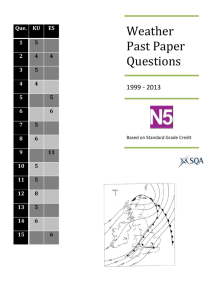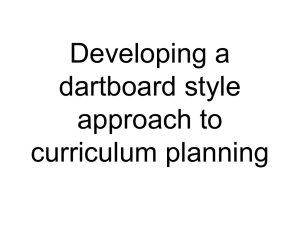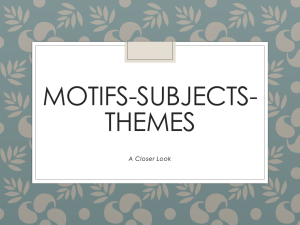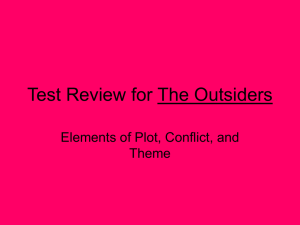Support and guidance - Unit 3, Contested Planet
advertisement
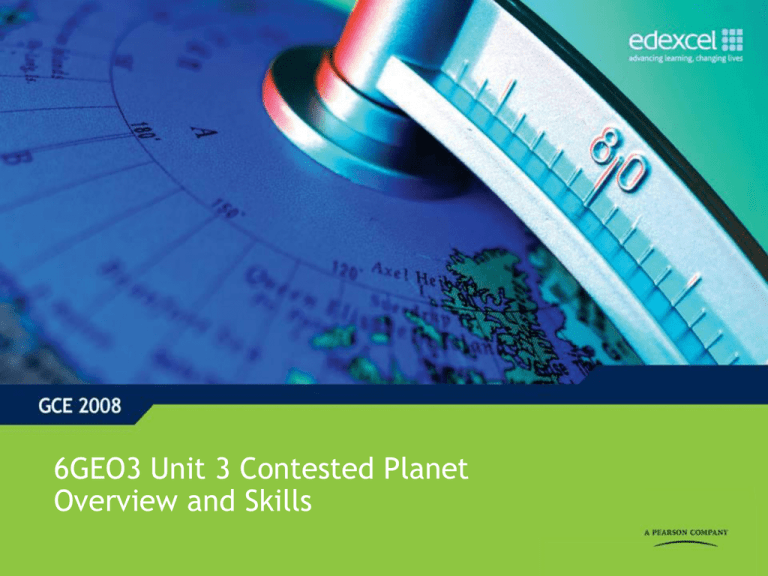
6GEO3 Unit 3 Contested Planet Overview and Skills What is this presentation about? • This presentation gives you an overview of Unit 3, Contested Planet • It outlines the content and structure of the Unit • The three synoptic themes of the Unit are explored – these are players, actions and futures. • Some key advice is given for each of the two parts of the examination (Sections A and B) Energy Security Technological Fix? Water Conflicts Contested Planet Biodiversity Under Threat Bridging the Development Gap Superpower Geographies CONTENTS 1. 2. 3. 4. Content and structure Synoptic themes Section A of the exam Section B of the exam Click on the information icon Click on the home button to jump to that section. to return to this contents page 1. Content and structure AS Level Unit 1 Global Challenges 60% CORE Unit 2 Geographical Investigations 40% OPTIONS A2 Level Unit 3 Contested Planet 60% CORE UNIT 4 Geographical Research 40% OPTIONS • Unit 3 forms the Core of A2 Geography • As with AS level, the weighting of the units is skewed towards the Core unit. • There are no Options in Unit 3, all of the content in the specification should be covered. The 6 topics of Contested Planet • The 6 topics in Contested Planet combine into a linked sequence. • This firstly explores resources, then the differences between rich and poor. • Finally a range of solutions to global problems and inequalities are examined in ‘Technological Fix’. This last topic is summative and would benefit from being taught last. Resources •1. Energy Security •2. Water Conflict •3. Biodiversity under Threat Wealth and Power •4.Superpower Geographies •5.Bridging the Development gap Solutions •6. The Technological Fix? Examination Structure • The Unit 3 exam has two sections, A and B • Section A has an element of choice for candidates ( 2 questions from 5) • Section B is compulsory for all candidates • Students must manage the balance of time spent on Sections A and B • The 5 section A questions are based on 5 or the 6 topics in the specification • The sixth topic forms the basis of the Synoptic Pre-Release resource booklet 2 ½ hour exam 90 marks Section A: Complete 2 questions from a choice of 5; questions are worth 25 marks (10 mark part ‘a’ and 15 mark part ‘b’) 80 minutes Section B: 3 Linked sub questions (6a, 6b, 6c) with a combined total of 40 marks, forming an Issues Analysis. 70 minutes Section B Synoptic topic • The topic for Section B is selected at random • The topic chosen cannot repeat within a single year e.g. Water Conflicts in January and June of one year • However, a topic could re-appear in the following year • The two diagrams illustrate the relationship between Sections A and B for two different exam sittings Section A •Q1 •Q2 •Q3 •Q4 •Q5 Water Conflicts Energy Security Biodiversity under Threat Bridging the Development Gap Technological Fix? •Q6a-c Superpower Geographies Section B Section A •Q1 •Q2 •Q3 •Q4 •Q5 Water Conflicts Energy Security Biodiversity under Threat Superpower Geographies Technological Fix? •Q6a-c Bridging the Development Gap Section B Teaching and Learning • • • • Only teaching 3 or 4 of the six Contested Planet topics will restrict student choice in Section A of the exam Only teaching 3 or 4 topics will reduce synoptic opportunities in Section B ‘Technological fix?’ examines a range of contrasting solutions to global and local issues related to energy, water, food supply and environmental issues – many of these approaches are integrated into the Water Conflicts, Energy Security and Bridging the Development Gap topics making Technological Fix? a summative overview of the Unit. There are strong links between Unit 1 at AS Level and Unit 3 at A 2 level which should be drawn out to assist students with the Section B issues analysis (see diagram for example) Biodiversity reduction due to climate stress Geoengineering fixes as a ‘solution’ to global warming Superpowers and emerging powers as the main greenhouse gas emitters Climate Change at AS level Water stress made worse by increasing aridity Fossil fuel use contributing to climate change 2. Synoptic themes • Three synoptic themes run through the Unit 3 specification • These themes are referred to directly in the specification • It is important to consider examples and case studies in the context of these themes • The themes will appear as the focus for some questions in both Section A and Section B Players Unit 3 Synoptic Themes Futures Actions Players • Players focuses on the organisations, groups and individuals who have a role to play within an issue • Players might be thought of as ‘decision makers’ or ‘stakeholders’ • Players may hold very different views on an issue, because they have different opinions and values • It is important students understand these different positions and perspectives CONSERVATIONISTS – an area of biodiversity to be protected from human activity INDIVIDUALS– an area to be enjoyed and explored; expectation that facilities and amenities will be available TOURISM INDUSTRY – an area for making profits, but also requiring conservation to maintain visitor numbers LOGGERS – an area of timber resources that could be exploited WATER INDUSTRY – an important source of freshwater to supply homes and industry Actions • Actions focuses on both the scale and standpoint of actions • There is a hierarchy of actions at different scales • There is often debate over which scale of management is best for a particular issue • Often an issue is managed at several scales • Chosen actions are influenced by players’ standpoints, especially political and economic beliefs Global agreements and international action National policy and management Local governance and individual actions Neo-liberal Socialist Grassroots Focus on commercial solutions and less government influence Focus on national planning and targets, often top-down Focus on bottom-up and sustainable, small scale initiatives International, market-led National, government led Local, community led Futures • Futures focuses on the direction the contested planet should take • Three future scenarios are recognised: Business as usual Sustainable Radical • The first implies humans continue to behave in similar ways to the past i.e. high consumption and pollution • Sustainable futures suggests stabilising consumption and human environmental impacts • Radical implies concerted action to reverse environmental degradation • Each of the three futures have very different consequences and are supported by different players • Each approach has very different costs and benefits 3. Section A of the exam • The five Section A questions are each worth 25 marks • Each question is split into a 10 mark part ‘a’, based on a Figure (resource) and a 15 mark part ‘b’. • Candidates should choose two questions • Spend no more than 40 minutes on each Section A question • Answers should be written in the dedicated space provided in the answer booklet Candidates should be very strict with timings, and keep an eye on the exam room clock Resources • Section A resources will be a mixture of graphs, maps, diagrams and other illustrative material such as cartoons • Some text may be present and this should always be carefully read • Figures are provided as data stimulus, and candidates will not be asked to ‘describe’ • Answers should focus on explanation and reasoning • Interpretation of Figures is a skills candidates should practice. Carefully read Figure titles, as well as scales, axes and keys if present Look for patterns, trends and relationships and seek to explain these Read any text, or notes, carefully Command words • Command words at A2 level will be different to those at AS level; some examples are shown below • In Section A in Unit 3 the ‘a’ parts will often use ‘explain’ or ‘suggest reasons’ whereas the ‘b’ parts will often focus on the higher level skills of ‘assess’ and ‘evaluate’ Assess, Evaluate, Discuss – A2 Level e.g. Section A part ‘b’ questions and Section B Explain, suggest reasons – AS Level and A2 level e.g. Unit 3 Section A part ‘a’ questions and Section B Describe, Contrast – AS Level Examples and case studies • Students must use examples to illustrate their argument and discussion when ever they can – even when not directly asked to do so in the question. • This is especially important when questions use phrases such as ‘costs and benefits’ or ‘advantages and disadvantages’. • Avoid relying on one major case study as this often produces descriptive and unbalanced responses – a range of smaller examples illustrating several different aspects of the question is preferable RANGE – more than one example BALANCE – avoid being onesided DETAIL – example specific facts and figures STRUCTURE – logical and organised writing EVALUATIVE – moving towards an overview / brief conclusion Mark schemes • All A2 work is Levels marked; there is no point marking • Levels mark schemes have a step-like structure, which successive levels requiring higher skills and greater precision: Assessment Some examples Range of examples Some examples Balanced Balanced costs and benefits Descriptive comments Some structure Structured Carefully structured Level 1 Level 2 Level 3 Level 4 4. Section B of the exam • Section B is a synoptic issues analysis • It is based on pre-release resources in the form of a 5-6 page booklet • Usually the resources will be based on a region such as Europe, the Middle East or North America • They will focus on ONE of the topics from Unit 3 e.g. Water Conflicts of Superpower Geographies • The resources are written to LINK to other topics; there will be both obvious and more subtle linkages. What is in the pre-release? • Text • Key words / terms • Figures – maps, tables, graphs etc • Views of players • Websites for further research • Options / choices may be included The pre-release phase • During the prerelease phase the aim is to become so familiar with the resource booklet that it does not have to be ‘read’ in the exam • Spending time in the exam reading and searching for information will waste time Make a glossary of key terms and research any new ideas and themes Analyse the ‘Views’ and be prepared to quote them Think about comparisons to parallel examples Working with the prerelease Look for synoptic links to other Unit 3 and Unit 1 topics, and global themes such as Climate Change or the Dev. Gap Look for evidence of players, actions and futures Do some selective research using the websites (and your own) Questions • There will be 3 questions, forming a linked sequence (6a, 6b, 6c) • Total marks are 40; the tariff for each question will be in the 10Refer to Figures and Views 18 range. directly e.g. “Fig 2 shows that…” Use examples and ideas from your whole course, where relevant The first question will tend to ‘set the scene’ or make you focus on a key issue Other questions will require you to assess or evaluate Being synoptic • In order to reach the top levels of the Mark Scheme in Section B, synopticity is required • Essentially this means going beyond only relying on the resources printed in the Resource Booklet • This can be achieved in several different ways: Wider research • Facts, figures and ideas from the suggested websites, or your own sources such as Geography Review or many other sources; remember to state your source Parallel examples • Comparing the situation(s) in the Resource Booklet to others you know of, briefly, to draw out similarities and differences, or suggest how the situation might be managed. Synoptic Links •Making links to other topics in Unit 3, or other AS / A2 Units; this might involve bringing in models, theories or examples from elsewhere in your course Context themes • Making links to the three synoptic themes of players, actions and futures, as well as global themes such as climate change, the development gap, sustainability etc. Final points on Section B • Make sure at least 70 minutes are set aside to complete Section B • Write to the mark allocation; a question worth 10 marks does not require an answer 3 sides long; a 16 mark question will need more than ¾ of one side. • Diagrams and tables are acceptable as part of an answer; complicated tables and scoring systems are not anticipated and will tend to take too long to complete • Highlight key and command words; for longer questions a very brief plan may help structure answers


